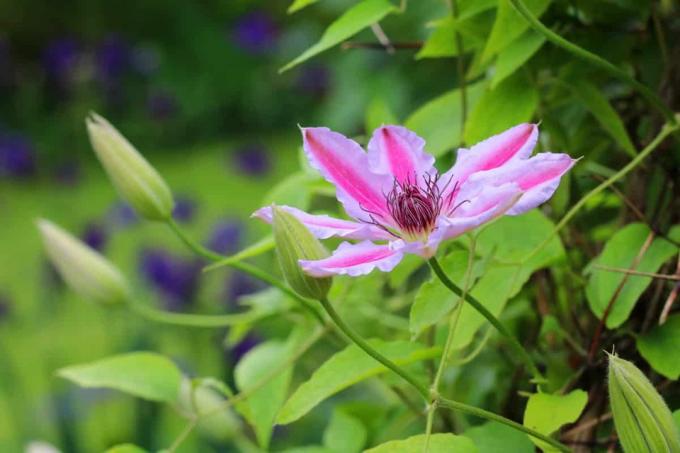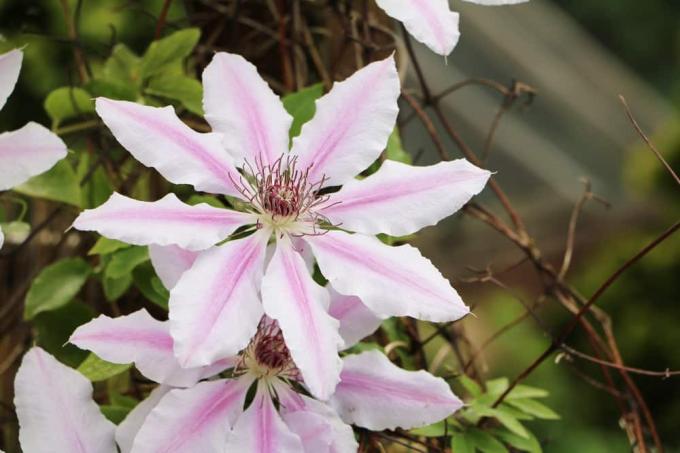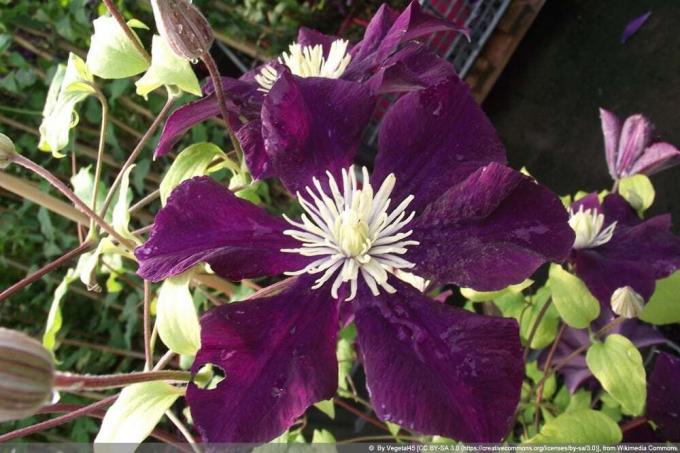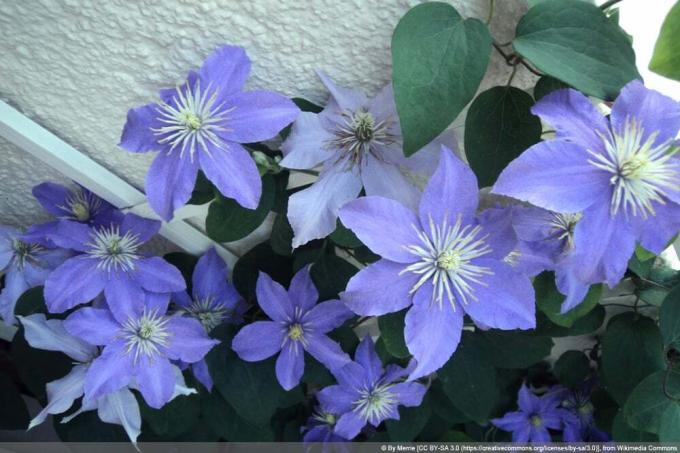

Table of contents
- growth
- blossom
- Location
- Floor
- plant out
- Bucket attitude
- Fertilize
- Pour
- Cut
- diseases and pests
- hibernate
Clematis 'The President' is a wonderful example of how even a simple flower can inspire with its clear color alone. The blue-violet also gains in luminosity because the flowers are numerous and, above all, huge. Their diameter can be up to 18 cm. It may come as a surprise, but this lavish beauty is extremely modest when it comes to her own needs.
growth
The perennial climbing plant Clematis 'The President' swings effortlessly up into the sky on pergolas, trellises and trellises. With a growth of about half a meter per year, it soon towers over all other plants. Even from a height of 5 m, their flowers can shine down on us. High up, her sight is no longer obscured by anything, even from afar, 'The President' cannot be overlooked. While it slumbers leafless and inconspicuous in winter, it unfolds magnificently in summer green foliage, which soon has to step back into the second row to give the flowers the stage leave.
blossom
The plain purple flowers are the largest the large clematis family has to offer. The flowers of this hybrid variety reach a diameter of approx. 18 cm. The size alone is impressive enough, so the petals are rather simple. When the violet shines from May, the green of the leaves only shimmers through here and there and forms a nice contrast to the color of the flowers. Then this clematis is a popular meeting place for numerous insects that don't want to miss their nectar and stop by for a snack. A hum concert sounds and testifies to the abundance of nature. A blessing for our noise-plagued ears. Its flowering continues into September.
Location
The ideal location for this flowering climber should be sunny or at least partially shaded. However, the roots of the clematis need shade, they must be protected by ground cover or mulch. A location where there is already a natural climbing opportunity is ideal. A tree trunk and a wall work well for this. Even an existing rose trellis can be covered with this clematis. The 'The President' variety also thrives extremely well in tubs and forms a colorful privacy screen in a short time. No matter where you plant clematis, make sure they are sheltered from the wind. Their tendrils cannot withstand strong winds and it would be a shame if some of them were to tear off.
Floor
The deep-rooted clematis cannot thrive in hard soil. The soil must be loose and permeable. If the earth is not of this nature by nature, it must subsequently be mixed with other components. Too sandy soil still needs water-storing garden soil, too loamy, compacted soil has to be loosened with sand. This is best done before the clematis is planted. Since the clematis needs a lot of nutrients and trace elements for the formation of the flowers, a high proportion of humus is an advantage. Horn shavings can also be placed in the planting hole.
plant out

If you can offer the clematis a garden, you are making her happy. She is content with one large pot, but that is nothing compared to the development possibilities she has in open soil. The President' is frost hardy, so this hybrid variety can easily overwinter outside.
- Planting time: March to October
- sunny to partially shaded location
- the planting hole should be about twice the size of the root ball
- Put horn shavings in the planting hole as long-term fertilizer
- Carefully remove from the pot so as not to damage the tendrils
- approx. Plant 10 cm deeper
- Planting distance between two clematis approx. 60 cm
- Distance to walls approx. 15 cm
- water well
- Water in the first few weeks depending on the weather
- Use ground cover to shade the root ball
- alternatively: spread a thick layer of mulch
Bucket attitude
Since climbing plants grow quickly, they are also often planted in planters to create terraces or balconies. At the same time, they also serve as a green privacy screen. Since the clematis 'The President' also flowers beautifully, it is at the top of the popularity list. It can also be cultivated in a pot, but not in the pot in which it is commercially available. While it may be sufficient for pre-cultivation and convenient for sale, it cannot meet their needs over the long term. She will need to be transplanted to a much larger pot fairly soon to continue developing.
- Obtain a bucket of min. 25 liters volume. It should have lots of holes in the bottom.
- Provide suitable soil. It should be loose and rich.
- First put a drainage layer of approx. 8 cm into the bucket.
- Fill some soil over it. The free space up to the edge of the bucket should be as high as the root of the clematis plus 10 cm.
- Carefully remove the clematis from its old pot. To do this, hold the pot overhead and let the plant slide out into your other hand.
- Stand the root ball straight in the new tub.
- Fill in the gaps with soil. Press them down lightly.
- If necessary, plant small plants that are supposed to keep the root ball in the shade.
- Now water the plant well.
- Place the bucket in a sunny or partially shaded spot.
- Attach a trellis so that the clematis can hold on to it.
Tip:
The ball of the clematis should remain as intact as possible when it is removed so that the roots are not damaged. Which is not a big problem with other plants, harms the clematis. The soil in the bucket should be replaced about every four to five years.
Fertilize
This richly flowering clematis needs an even supply of nutrients almost all the time – with the exception of winter. Only then will they please you with beautiful flowers. Horn shavings and other organic fertilizers are best, which are spread around the roots and lightly worked in in the spring from March to April. Further fertilization should be done with compost. It will be released in December. This clematis should not be fertilized during the flowering period, as this can shorten the flowering period.
Pour
If there is no rain for a long time in summer, the clematis must be watered. Especially in their growth and flowering phase from April to September, their roots must be in sufficiently moist soil. Because they absorb the nutrients necessary for the flowers together with water. If a clematis plant is dry for a long time, the formation of flowers suffers. The more your location is irradiated by the sun, the more often the watering can has to be picked up. Only allow the top layer of soil to dry slightly. For the rest of the year, the clematis, with its long and deep roots, is perfectly capable of taking care of itself. It copes well with the residual moisture present in the soil. A few rules must be observed when watering the clematis:
- Waterlogging damages the roots
- young plants need to be watered more often
- Soil in pots dries out faster
- Water the bucket clematis regularly
- Buckets should have large drainage holes
- Drainage layer allows water to drain well
- rather water less and more often
Cut

The right cut ensures that the clematis is adorned with flowers every year. When the clematis is cut and how much is cut off depends on its flowering behavior. Based on this, the clematis varieties were divided into three different pruning groups. The variety 'The President' flowers from May/June and, like most large-flowered clematis, belongs to the second group. The following applies to plants in this group:
- Pruning time in late autumn after flowering
- Cut away weak and dead shoots first
- Shorten other shoots by 20 cm each
- use sharp and clean secateurs
- Gardening gloves protect against contact allergies (slightly toxic)
- after the first flowering, remove inflorescences and the underlying pair of leaves
No matter what pruning group a clematis belongs to, in the first winter after planting it should be shortened to about 30 cm above the ground. This encourages branching. Every four to five years, 'The President' should also be cut back heavily in the spring. This prevents bareness in the lower area. However, flowering is sparse in the following summer.
Tip:
The early bloomer 'The President' flowers on last year's shoots. It is therefore important that when pruning, some of these shoots are left standing. Also use the pruning shears for dead tendrils. Pulling at it could damage roots.
diseases and pests
The dreaded wilt does not stop at this clematis either. If the above-ground parts of the plant are infested, they must be cut off close to the ground. Leaves lying on the ground must be collected. Unfortunately, if the roots of the plant are affected by the fungus, the clematis can no longer be helped.
Powdery mildew can occasionally occur and should be fought early to prevent the infestation from spreading further.
Voles are a real nuisance in the garden. They seem to like the roots of the clematis. Unfortunately, they don't leave any of it, so the rootless plant eventually dies. If a grid protection is placed around the root ball when planting, the voles can no longer get to the tasty roots.
hibernate
Clematis 'The President' is hardy. She can overwinter outdoors unless growing in a pot. In this case, the clematis should winter in a bright and cool room. If no suitable winter quarters are available, they can also stay outside. In order not only to hope for a mild winter, the pot with the roots should be well prepared for the winter. A sheltered location keeps icy winds away. In addition, the pot should be insulated by wrapping it with plenty of fleece.
A winter cover can not harm the outdoor clematis either, especially if the vine is still young. A layer of fir branches protects their roots from very cold temperatures.
 garden editorial
garden editorial I write about everything that interests me in my garden.
Learn more about clematis

Lice, beetles & co: common clematis pests
Above and below ground there are many pests that can pose a threat to clematis. Without suitable countermeasures, some pests can damage a magnificent perennial so much within a few days that it dies.

Pruning clematis: Instructions for late and early flowering varieties
Clematis is known and loved for its diverse flower shapes and colors. The plants, also known as clematis, are extremely decorative plants that can be used in many places in the garden to green trellises, pergolas, arbors and walls.

Clematis gets brown leaves - combat clematis wilt
Clematis wilt is a menacing disease that occasionally afflicts clematis. Especially the popular, large-flowered hybrids are being swept away at high speed. Left to its own devices, the clematis is helplessly at the mercy of the fungal pathogen. However, with the help of her owner, she is able to survive.

Clematis 'Warszawska Nike' Warsaw Night - care and pruning
The Clematis 'Warszawska Nike' Warsaw Night scores with its flowers. With the easy-care climbing plant you definitely get an eye-catcher in the garden. Only the cut is a bit difficult and requires courageous access. More about this is here.

Clematis 'Justa' clematis - profile, care and cutting
Clematis 'Justa' clematis is a dwarf variety that has strong growth. In the summertime, the plant adorns itself with beautiful purple flowers that can also shine light blue. The clematis grows climbing and can reach a considerable height.

Clematis 'Nelly Moser' - pruning and care from A-Z
The clematis 'Nelly Moser' inspires with delicate pink flowers. A strong violet central stripe on each petal and the red stamens add harmonious color accents. In May and June, it unleashes a veritable explosion of flowers. With proper care, it also gives away a second bloom.
